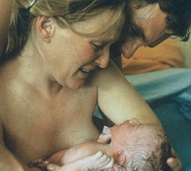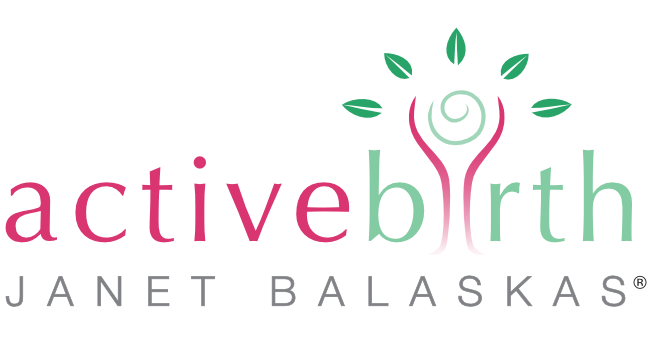
Some babies are in the breech position in late pregnancy – its not uncommon! A high proportion of breech babies do turn head down spontaneously, especially with a little encouragement so maybe the info below will be helpful.
When a baby is in the breech position, the head lies beneath the mother’s ribs and the buttocks or sometimes the feet are the presenting part positioned above the pelvis. There are several leg positions the baby can be in – some easier for vaginal birth than others. The majority turn head down in the last few weeks, and some do so just before the birth.
A number of babies remain in the breech position and can sometimes be born vaginally without complications. However, these days routine intervention is usually recommended so if your baby is still in the breech position at 34 weeks, you may wish to start encouraging a turn by following the suggestions below. There is an excellent leaflet on natural breech birth published by AIMS which can be obtained through the internet.
Breech Birth Options
You may wish to discuss your options with your birth attendants and explore possibilities for a vaginal breech birth. If your midwife, doctor or hospital is opposed to a trial of labour and routinely delivers breech babies by elective caesarian section, there might be other professionals or another place of birth who would support vaginal breech birth.
It’s a good idea to familiarise yourself with the obstetric procedures used to assist a baby in the breech position to be born, in the event of an active birth not being possible. When a breech labour does not progress well, or the baby’s head is considered to be large in relation to the pelvic diameters or the lie is not favourable, it is safest for the baby to be born by caesarian section.
You can wait until labour starts naturally before having a CS, if you prefer to. This will have the benefit of letting the baby come to full term, whereas a planned elective CS although more convenient, may be earlier than nature intended. As the baby’s lungs mature ready for breathing in the last weeks, respiratory problems can be avoided by waiting for the signals that baby is ready to be born.
These days a CS birth is safer than ever and can be a very good experience for all concerned, so try not to be worried in case the birth has to happen this way. And there is a good chance it may not.
There is also now a new approach towards trying to achieve a ‘natural caesarian‘ whereby the procedure is slowed down and the baby is gently ‘born’ into a calm, quiet and dim environment to try to replicate as close as possible the circumstances of a vaginal delivery.
Acupuncture can be successful in encouraging breech babies to turn. This is usually done with heat treatment (Moksha) on a point on the outside of the little toe and you can also take the homoepathic remedy pulsatilla before and after the session to encourage movement of the baby. You can get this from a homoepathic pharmacy. Speak to the homeopath to get a high potency in a powder form for 2 doses, to encourage a breech baby to move. Pulsatilla is a remedy that promotes change. Maternity reflexology also has a high success rate. All of these therapies are available from our therapy clinic at the Active Birth Centre.
There is also a medical procedure called an ‘external version’ whereby and obstetrician can try to turn the baby manually from the outside, using ultrasound at the same tome to monitor the progress. You can ask your support team about this and the success rates and risks involved so you can follow your own feelings about this. Some women find this quite invasive and uncomfortable, while others do not mind. Being very relaxed and doing yoga breathing will help. Ask them to be gentle and to give up if baby does not seem to want to turn.
Self-help suggestions to encourage your baby to turn
Walking for up to an hour a day may encourage your baby’s head – the heaviest part of the body – to gravitate downwards. (Do not do this if you have pelvic pain.)
Get a physio ball – 65cms (or 75cms if you are tall). Blow it up so that when you sit on it, knees apart with your feet flat on the floor, your hips are higher than your knees. From now on use instead of a chair. Do a little GENTLE bouncing a few times a day – this will encourage the head down.
The exercises attached can be practised several times daily for up to 10 minutes each. Results are not usually immediate, but keep trying as your baby may turn at any time, right up to the beginning of labour. To prevent the breech engaging in the pelvic brim, avoid squatting. If you suspect that your baby has turned, stop doing the exercises and have a check up to confirm the baby’s position. These exercises, by taking the baby away from the pelvis basically prevent the breech from getting engaged in the pelvic brim which would make it much harder or impossible for the baby to turn. Then the remedy and the acupuncture get the baby moving and the walking and bouncing on the ball encourage the head down.
Exercises
 Start with the hips raised lying on the back– it take a bit to get into it at first – but once there relax and breathe and visualise the baby turning, massaging your belly in only the direction easiest for baby to turn (ask at your next check up and listen to your instincts). Talk to your baby ‘inside’, encouraging him or her to turn.
Start with the hips raised lying on the back– it take a bit to get into it at first – but once there relax and breathe and visualise the baby turning, massaging your belly in only the direction easiest for baby to turn (ask at your next check up and listen to your instincts). Talk to your baby ‘inside’, encouraging him or her to turn.
Stay in the position for about 10 minutes or so and then gently roll onto your side. (If you are used to practicing yoga and are familiar with the shoulder stand, you can do a half shoulder stand on the wall with knees bent, then get someone to put lots of cushions or a beanbag under your hips and lower them and relax. This will lift your pelvis up a little higher.) Take your time rolling off the pillows, slowly to the side.
 Now change immediately to the knee chest for another 10 minutes, Repeat this several times a day and be patient as it may take a while for anything to happen – could even be just before labour starts that baby decides to move. You are likely to notice a lot of movement and a sense that things may have changed if the baby turns. Get it checked if you think this has happened and stop the exercises.
Now change immediately to the knee chest for another 10 minutes, Repeat this several times a day and be patient as it may take a while for anything to happen – could even be just before labour starts that baby decides to move. You are likely to notice a lot of movement and a sense that things may have changed if the baby turns. Get it checked if you think this has happened and stop the exercises.
It’s also worth exploring whether you have any fears or issues around the birth and, if so, finding an appropriate person to talk with. Sometimes releasing feelings and clearing any doubts or fears can help the baby to settle into the pelvis ready for birth.
Your hypnobirthing instructor may be able to give you a guided relaxation to encourage baby to turn. You can use this while doing the exercises or during an external version.
If you need more advice, Janet offers private coaching on breech babies via zoom


Number of times, over the years, that the earthing and nurturing power of reflexology to encourage a breech baby to turn head down has worked! Sometimes the mother’s deepest relaxation and instinctive reconnection seems to do the trick-although some babies never turn, whatever is attempted, so a space of acceptance is important so as to look forward to a different kind of birthing experience…